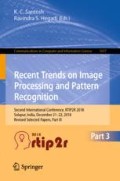Abstract
This article proposes an minimum distance based edge linking algorithms for handwritten character images. Improvement of performance for machine recognition is challenging task due to noise and degraded input images. In the proposed system we enhance the recognition rate of object reconstruction for broken edges by using edge linking. Such edges of objects are reconstructed by using novel Distance based Edge Linking (DEL) approach. Developed new benchmark approach is fill the gaps between nearest edge segment of Binary image map (BIM). We obtain state-of-art performance of proposed system on character recognition (CR) using two datasets MNIST and ISI.
Access this chapter
Tax calculation will be finalised at checkout
Purchases are for personal use only
References
Akinlar, C., Chome, E.: PEL: a predictive edge linking algorithm. J. Vis. Commun. Image Represent. 36, 159–171 (2016)
Bresenham, J.: A linear algorithm for incremental digital display of circular arcs. Commun. ACM 20(2), 100–106 (1977)
Canny, J.: A computational approach to edge detection. IEEE Trans. Pattern Anal. Mach. Intell. 6, 679–698 (1986)
Dorigo, M., Birattari, M., Stutzle, T.: Ant colony optimization. IEEE Comput. Intell. Mag. 1(4), 28–39 (2006)
Jiang, J.-A., Chuang, C.-L., Lu, Y.-L., Fahn, C.-S.: Mathematical-morphology-based edge detectors for detection of thin edges in low-contrast regions. IET Image Proc. 1(3), 269–277 (2007)
Kamble, P.M., Hegadi, R.S.: Handwritten Marathi basic character recognition using statistical method. In: Emerging Research in Computing, Information, Communication and Applications, vol. 3, pp. 28–33. Elsevier (2014)
Kamble, P.M., Hegadi, R.S.: Deep neural network for handwritten Marathi character recognition. Int. J. Imaging Robot.\(^{TM}\) 17(1), 95–107 (2017)
Liu, H., Jezek, K.C.: Automated extraction of coastline from satellite imagery by integrating canny edge detection and locally adaptive thresholding methods. Int. J. Remote Sens. 25(5), 937–958 (2004)
Lu, D.-S., Chen, C.-C.: Edge detection improvement by ant colony optimization. Pattern Recogn. Lett. 29(4), 416–425 (2008)
Pal, U., Chaudhuri, B.B.: Indian script character recognition: a survey. Pattern Recogn. 37(9), 1887–1899 (2004)
Qiao, Y.: Modified national institute of standards and technology database (MNIST) (2007). http://www.gavo.t.u-tokyo.ac.jp/~qiao/database.html
Ramsay, J.O.: Kernel smoothing approaches to nonparametric item characteristic curve estimation. Psychometrika 56(4), 611–630 (1991)
Santosh, K.C., Nattee, C., Lamiroy, B.: Spatial similarity based stroke number and order free clustering. In: 2010 12th International Conference on Frontiers in Handwriting Recognition, pp. 652–657. IEEE (2010)
Santosh, K.C., Nattee, C., Lamiroy, B.: Relative positioning of stroke-based clustering: a new approach to online handwritten Devanagari character recognition. Int. J. Image Graph. 12(02), 1250016 (2012)
Santosh, K.C., Wendling, L.: Character recognition based on non-linear multi-projection profiles measure. Front. Comput. Sci. 9(5), 678–690 (2015)
Shih, F.Y., Cheng, S.: Adaptive mathematical morphology for edge linking. Inf. Sci. 167(1), 9–21 (2004)
Tsang, P.W.M.: A genetic algorithm for affine invariant recognition of object shapes from broken boundaries. Pattern Recogn. Lett. 18(7), 631–639 (1997)
Wei, L., Peng, D., et al.: An improved sequential edge linking model for contour detection in medical images. In: 4th IEEE Conference on Industrial Electronics and Applications, ICIEA 2009, pp. 3757–3760. IEEE (2009)
Whichello, A.P., Yan, H.: Linking broken character borders with variable sized masks to improve recognition. Pattern Recogn. 29(8), 1429–1435 (1996)
Zhou, Y., Starkey, J., Mansinha, L.: Segmentation of petrographic images by integrating edge detection and region growing. Comput. Geosci. 30(8), 817–831 (2004)
Author information
Authors and Affiliations
Corresponding authors
Editor information
Editors and Affiliations
Rights and permissions
Copyright information
© 2019 Springer Nature Singapore Pte Ltd.
About this paper
Cite this paper
Kamble, P.M., Hegadi, R.S., Hegadi, R.S. (2019). Distance Based Edge Linking (DEL) for Character Recognition. In: Santosh, K., Hegadi, R. (eds) Recent Trends in Image Processing and Pattern Recognition. RTIP2R 2018. Communications in Computer and Information Science, vol 1037. Springer, Singapore. https://doi.org/10.1007/978-981-13-9187-3_23
Download citation
DOI: https://doi.org/10.1007/978-981-13-9187-3_23
Published:
Publisher Name: Springer, Singapore
Print ISBN: 978-981-13-9186-6
Online ISBN: 978-981-13-9187-3
eBook Packages: Computer ScienceComputer Science (R0)

